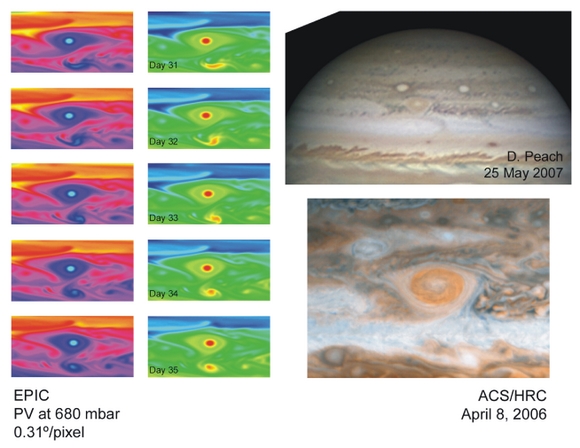As far as storms go, nothing will rival Jupiter’s Great Red Spot (GRS). But of interest is a smaller and newer storm called Oval BA, a giant anticyclone on Jupiter also known as Red Spot Junior. ‘Smaller’ is a relative term, as although Oval BA is about half the size of GRS, it has a diameter about the size of our Earth. It formed in 2000 as several vortices converged. However, recently Oval BA has undergone some changes. Suddenly it turned from white to red in a period of just a few months, and planetary scientists are trying to understand the processes that could cause the changes. While they are able to explain some of Red Spot Junior’s attributes, they are puzzled by others.
“Our group has made an in-depth analysis of all the aspects regarding the history and evolution of Oval BA,” said Dr. Santiago Pérez-Hoyos, of the Planetary Science Group of the University of the Basque Country in Spain. “The most strongly reddened region was an annulus around its centre. However, when we calibrated images taken with the Hubble Space Telescope, we found that it didn’t actually alter in red or infrared wavelengths during the period. Instead, it became darker in blue and ultraviolet wavelengths, which made it appear visually redder.â€
The apparent reddening was first reported by amateur astronomers in early 2006, but it was not until April that professional astronomers were able to image the impressive alteration of the second largest storm in the Solar System after the Great Red Spot (GRS).
Using data from Cassini, the Hubble Space Telescope, NASA’s New Horizons mission and computer models the Planetary Science Group analyzed possible causes for the color change, including alterations to dynamical, photochemical and diffusion processes.
Pérez-Hoyos said, “The most likely cause appears to be an upward and inward diffusion of either a colored compound or a coating vapor that may interact later with high energy solar photons at the upper levels of Oval BA.â€
The group were able to rule out that the reddening was caused by any dynamical processes. They found no change to the strength of the “hurricane†and, although some changes in the circulation around the spot had taken place, the maximum wind speeds (which may range up to 400 kilometers per hour or more) were consistent with measurements previous to 2000 of the storms that combined to form Oval BA.
The group modeled the wind flow in detail using high resolution simulations, in order to understand why the red material may be confined to the annulus region and how the color change happened in the observed time scales. The model accounts well for the temperature and wind structure inside the oval BA.
Models also showed that the change could not be attributed to interactions of Oval BA with the GRS, which were relatively close at the time. The flow around both vortices is in the zonal directions and is so strong that separates both storms
The oval height did not change over the period and there were no large changes in the temperature gradient of the oval.
Pérez-Hoyos said, “There is much to be understood about this problem yet. Future spacecraft missions and a continuous observation of the planet (as done by amateur astronomers) will surely give us new clues on the behaviour of Jupiter’s atmosphere that will result in a better understanding of it.â€
The team presented their findings at the European Planetary Science Congress in Münster on Monday, 22nd September.
Source: European Planetary Conference


Nice article.
To think that there is a storm on Jupiter the size of our planet… Imagine if all of Earth was covered in a storm at once, and that storm lasted for hundreds of years.
That means my power would go out again. 🙁
Not to worry, it’s probably just the monolith up to its old shenanigans.
I was struck by the illustration with this article containing the stunning image by amateur astronomer Damian Peach with a relatively small ‘scope compared to the HST image. Planetary imaging by amateurs has sure come a long way since the days of 35mm film photography and eyepiece projection techniques. And it’s nice to see how the professional community has benefitted from this over the past several years.
Jupiter!!!
My personal favorite.
If Phil Plait gained about a hundred pounds, then he would also be an Oval BA.
will this distroy jupider?